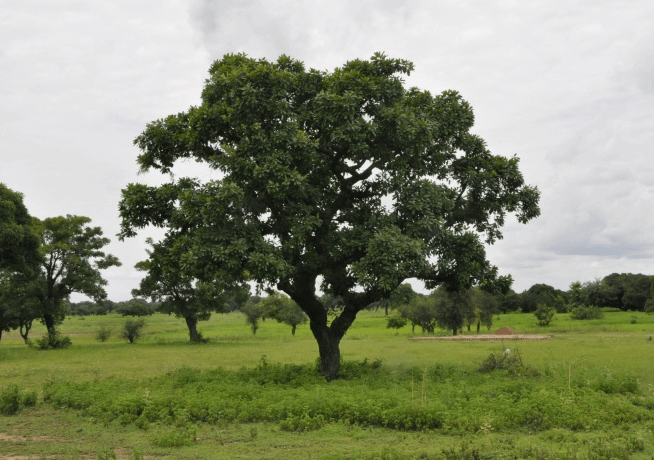In this article, we will explore the fascinating world of Burkina Faso National Tree, the shea tree (Vitellaria paradoxa). As a country expert, we will provide you with a detailed overview of this remarkable tree, its significance, traditional uses, economic importance, and the conservation efforts surrounding it. Join us as we delve into the rich cultural and ecological heritage of the shea tree in Burkina Faso.
Importance of the Burkina Faso National Tree
The shea tree holds immense importance in the lives of Burkina Faso's people. It is not only a symbol of national pride but also a vital natural resource that contributes to the country's economy and sustenance. The tree's numerous benefits make it a valuable asset for the local communities and the wider world.
Habitat and Distribution
The shea tree thrives in the savannah regions of Burkina Faso, particularly in the southern parts of the country. Its natural habitat includes woodland areas with well-drained soils. The distribution of shea trees extends beyond Burkina Faso, encompassing other countries in West Africa, such as Ghana, Nigeria, and Mali.
Shea Tree Characteristics
The shea tree is a deciduous tree with a distinctive appearance. It can reach heights of up to 15 meters and has a broad, spreading crown. The tree's trunk is rugged, and its branches are covered in dense foliage, providing shade in the scorching heat. The shea tree's leaves are elongated and alternate along the branches, creating a beautiful canopy.
Traditional and Economic Uses
For centuries, the shea tree has been an integral part of the local culture and traditional practices in Burkina Faso. Its fruits, nuts, and leaves find diverse applications in cooking, medicine, cosmetics, and craftsmanship. The shea nut is particularly valuable, as it is the primary source of shea butter, a prized ingredient known for its moisturizing and healing properties.
Shea Butter Production
The process of shea butter production involves a series of labor-intensive steps. After harvesting the shea fruits, the nuts are carefully extracted and dried. The next stage involves cracking the nuts and grinding them into a paste. This paste is then kneaded and boiled to extract the shea butter, which is further processed and refined for various uses.
Cultural Significance of Burkina Faso National Tree
Beyond its practical uses, the shea tree holds cultural significance in Burkina Faso. It is often associated with fertility, protection, and female empowerment. Shea butter is traditionally used in rituals, ceremonies, and celebrations, reflecting the tree's deep-rooted cultural heritage.
Conservation Efforts for Burkina Faso National Tree
Recognizing the ecological and economic importance of the shea tree, conservation efforts have been initiated to safeguard its future. Local communities, NGOs, and governmental organizations work together to promote sustainable harvesting practices, reforestation initiatives, and the protection of shea tree habitats. These efforts aim to balance the utilization of shea resources with the preservation of biodiversity.
Challenges and Threats to Burkina Faso National Tree
Despite its resilience, the shea tree faces several challenges and threats. Climate change, deforestation, and unsustainable harvesting practices pose risks to the tree's population and its associated ecosystems. Collaborative efforts and increased awareness are crucial to address these challenges and ensure the long-term survival of the shea tree.
Conclusion
The shea tree, Burkina Faso's national tree, is a remarkable natural resource that plays a significant role in the lives of the country's people. Its multifaceted uses, cultural importance, and economic value make it a tree of immense significance. Through sustainable practices and conservation efforts, we can preserve the shea tree's legacy for future generations, promoting a harmonious coexistence between humans and nature.
FAQs
1. What is the scientific name of the shea tree?
The scientific name of the shea tree is Vitellaria paradoxa.
2. Is shea butter only used in cosmetics?
No, shea butter finds uses in various industries, including cooking, medicine, and craftsmanship.
3. Are there any regulations in place to protect the shea tree?
Yes, conservation efforts and regulations exist to promote sustainable harvesting and protect shea tree habitats.
4. How long does it take for a shea tree to bear fruits?
Shea trees typically start bearing fruits after about 15 years of growth.
5. Can shea butter be used by people with sensitive skin?
Yes, shea butter is known for its gentle and nourishing properties, making it suitable for people with sensitive skin.
References:
- National Geographic Society. (n.d.). Shea Tree. Retrieved from https://www.nationalgeographic.org/encyclopedia/shea-tree/
- UNCCD. (2021). Vitellaria paradoxa. Retrieved from https://www.unccd.int/actions/combating-desertification-and-land-degradation/good-practices/vitellaria-paradoxa
- Sustainable Development Goals Knowledge Platform. (n.d.). Shea tree (Vitellaria paradoxa). Retrieved from https://sustainabledevelopment.un.org/partnership/?p=4107
